Financial Accounting: Detailed Client Case Study Analysis Report
VerifiedAdded on 2020/06/03
|33
|4290
|229
Report
AI Summary
This comprehensive financial accounting report delves into various aspects of the field through several client case studies. It begins with an introduction to financial accounting, covering key regulations, accounting rules, and principles, including consistency and materiality. The report then presents detailed analyses for six clients, including journal entries, ledgers, trial balances, income statements, and statements of financial position. Furthermore, the report covers the calculation of profit margins, assets, and liabilities, along with an evaluation of depreciation methods and bank reconciliation statements. Control accounts, suspense accounts, and the differences between suspense and clearing accounts are also explored. The report provides a practical understanding of financial accounting, making it a valuable resource for students studying accounting principles and their practical applications.

Financial Accounting
Paraphrase This Document
Need a fresh take? Get an instant paraphrase of this document with our AI Paraphraser
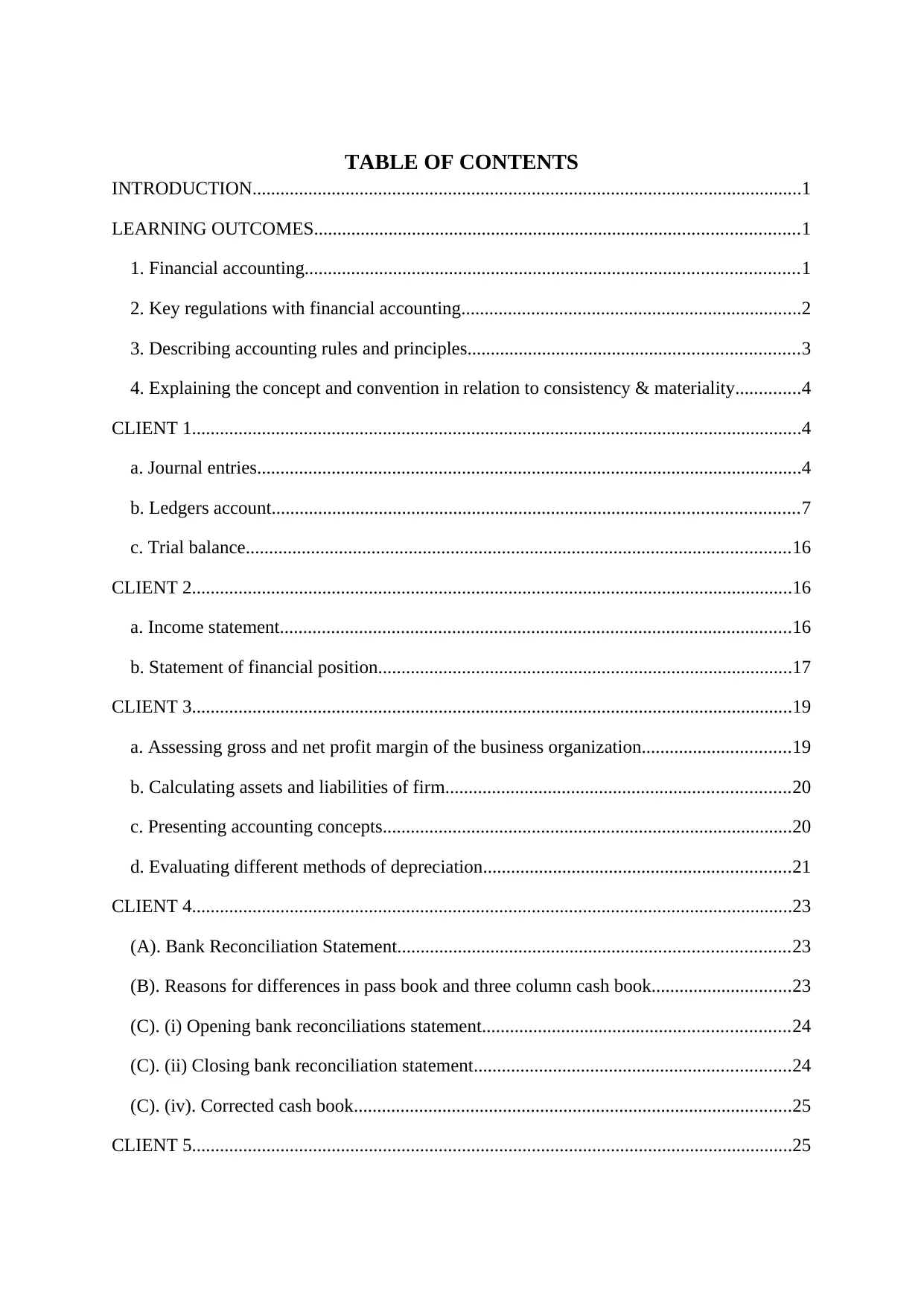
TABLE OF CONTENTS
INTRODUCTION......................................................................................................................1
LEARNING OUTCOMES........................................................................................................1
1. Financial accounting..........................................................................................................1
2. Key regulations with financial accounting.........................................................................2
3. Describing accounting rules and principles.......................................................................3
4. Explaining the concept and convention in relation to consistency & materiality..............4
CLIENT 1...................................................................................................................................4
a. Journal entries.....................................................................................................................4
b. Ledgers account.................................................................................................................7
c. Trial balance.....................................................................................................................16
CLIENT 2.................................................................................................................................16
a. Income statement..............................................................................................................16
b. Statement of financial position.........................................................................................17
CLIENT 3.................................................................................................................................19
a. Assessing gross and net profit margin of the business organization................................19
b. Calculating assets and liabilities of firm..........................................................................20
c. Presenting accounting concepts........................................................................................20
d. Evaluating different methods of depreciation..................................................................21
CLIENT 4.................................................................................................................................23
(A). Bank Reconciliation Statement....................................................................................23
(B). Reasons for differences in pass book and three column cash book..............................23
(C). (i) Opening bank reconciliations statement..................................................................24
(C). (ii) Closing bank reconciliation statement....................................................................24
(C). (iv). Corrected cash book..............................................................................................25
CLIENT 5.................................................................................................................................25
INTRODUCTION......................................................................................................................1
LEARNING OUTCOMES........................................................................................................1
1. Financial accounting..........................................................................................................1
2. Key regulations with financial accounting.........................................................................2
3. Describing accounting rules and principles.......................................................................3
4. Explaining the concept and convention in relation to consistency & materiality..............4
CLIENT 1...................................................................................................................................4
a. Journal entries.....................................................................................................................4
b. Ledgers account.................................................................................................................7
c. Trial balance.....................................................................................................................16
CLIENT 2.................................................................................................................................16
a. Income statement..............................................................................................................16
b. Statement of financial position.........................................................................................17
CLIENT 3.................................................................................................................................19
a. Assessing gross and net profit margin of the business organization................................19
b. Calculating assets and liabilities of firm..........................................................................20
c. Presenting accounting concepts........................................................................................20
d. Evaluating different methods of depreciation..................................................................21
CLIENT 4.................................................................................................................................23
(A). Bank Reconciliation Statement....................................................................................23
(B). Reasons for differences in pass book and three column cash book..............................23
(C). (i) Opening bank reconciliations statement..................................................................24
(C). (ii) Closing bank reconciliation statement....................................................................24
(C). (iv). Corrected cash book..............................................................................................25
CLIENT 5.................................................................................................................................25
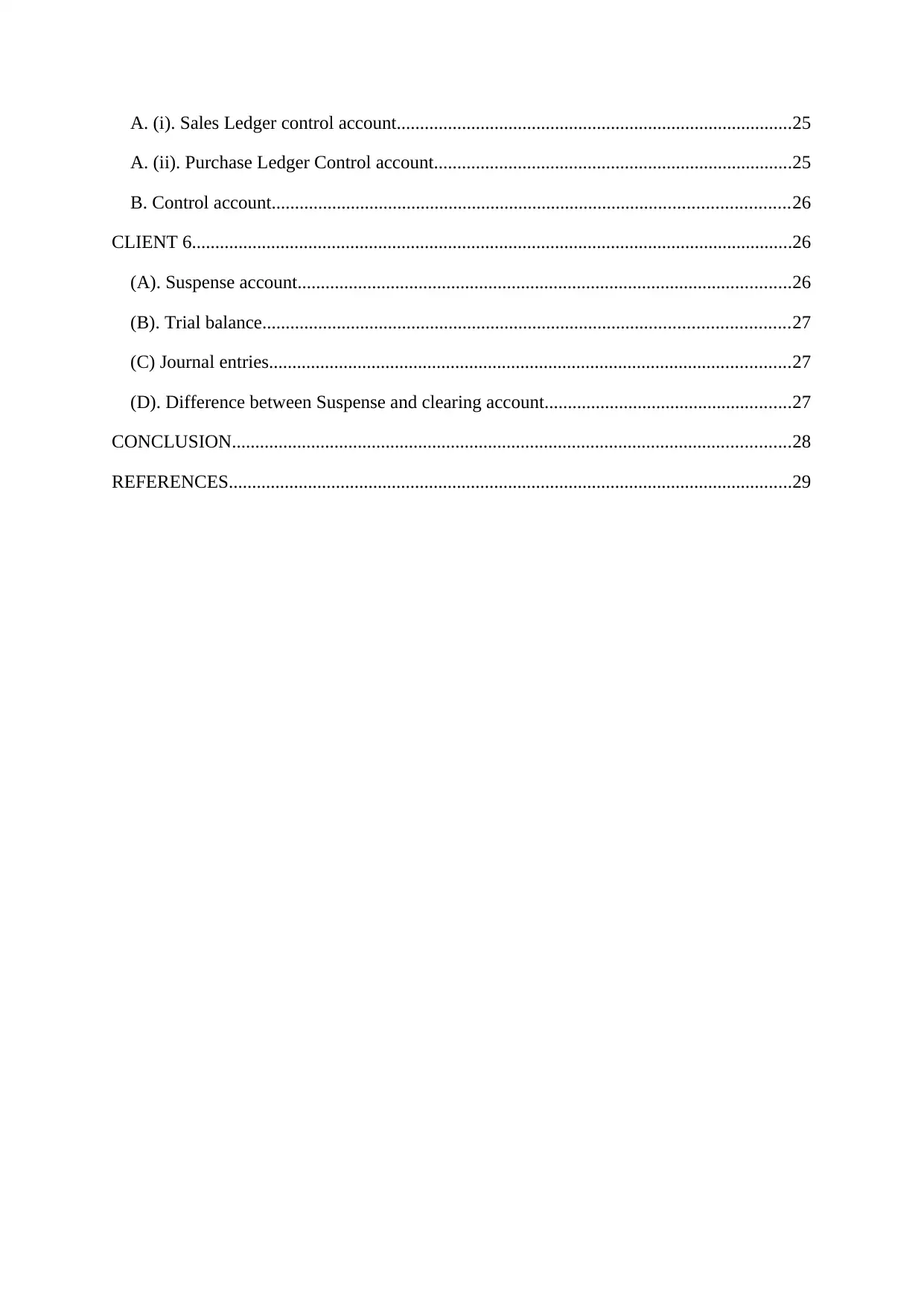
A. (i). Sales Ledger control account.....................................................................................25
A. (ii). Purchase Ledger Control account.............................................................................25
B. Control account...............................................................................................................26
CLIENT 6.................................................................................................................................26
(A). Suspense account..........................................................................................................26
(B). Trial balance.................................................................................................................27
(C) Journal entries................................................................................................................27
(D). Difference between Suspense and clearing account.....................................................27
CONCLUSION........................................................................................................................28
REFERENCES.........................................................................................................................29
A. (ii). Purchase Ledger Control account.............................................................................25
B. Control account...............................................................................................................26
CLIENT 6.................................................................................................................................26
(A). Suspense account..........................................................................................................26
(B). Trial balance.................................................................................................................27
(C) Journal entries................................................................................................................27
(D). Difference between Suspense and clearing account.....................................................27
CONCLUSION........................................................................................................................28
REFERENCES.........................................................................................................................29
⊘ This is a preview!⊘
Do you want full access?
Subscribe today to unlock all pages.

Trusted by 1+ million students worldwide
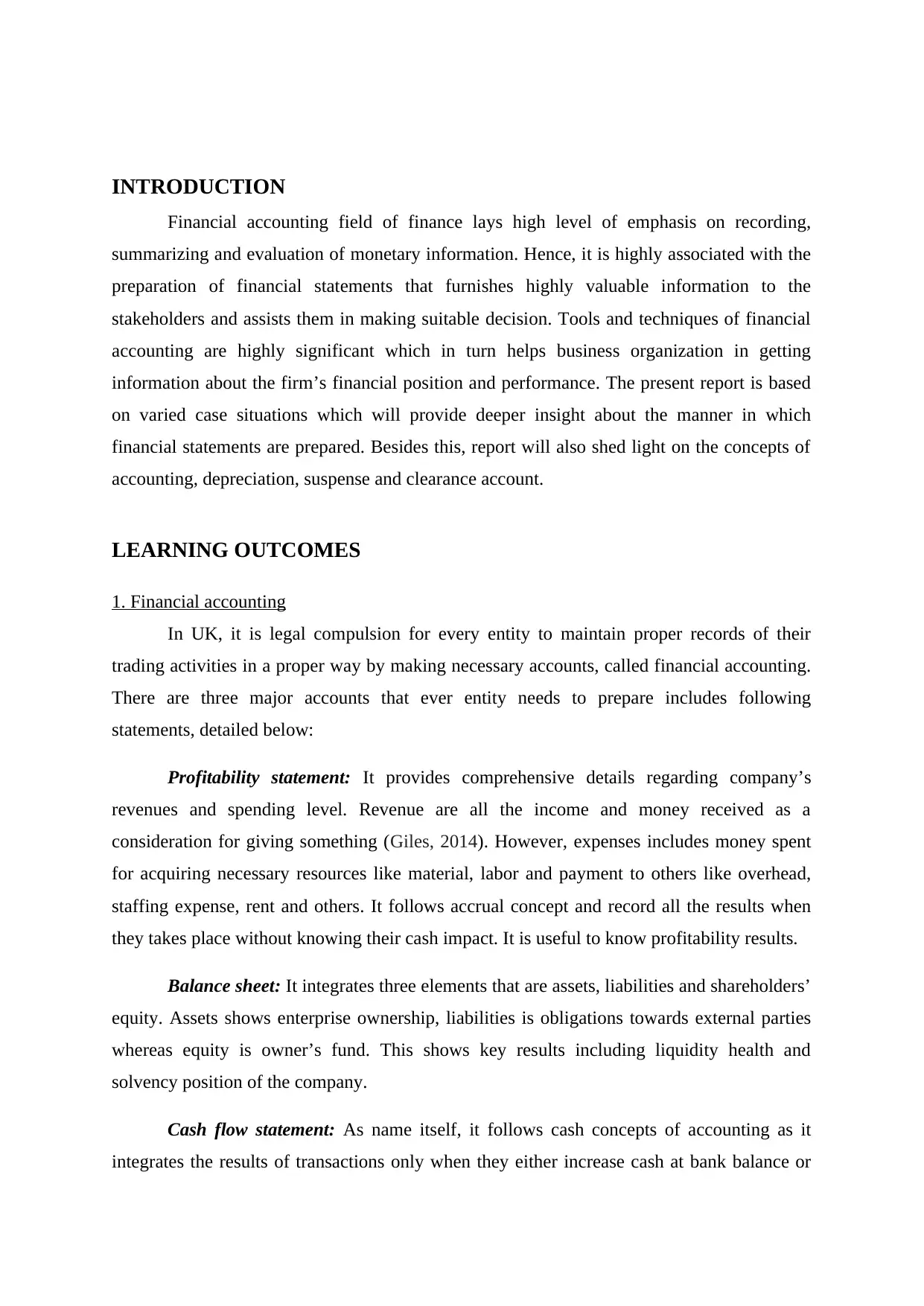
INTRODUCTION
Financial accounting field of finance lays high level of emphasis on recording,
summarizing and evaluation of monetary information. Hence, it is highly associated with the
preparation of financial statements that furnishes highly valuable information to the
stakeholders and assists them in making suitable decision. Tools and techniques of financial
accounting are highly significant which in turn helps business organization in getting
information about the firm’s financial position and performance. The present report is based
on varied case situations which will provide deeper insight about the manner in which
financial statements are prepared. Besides this, report will also shed light on the concepts of
accounting, depreciation, suspense and clearance account.
LEARNING OUTCOMES
1. Financial accounting
In UK, it is legal compulsion for every entity to maintain proper records of their
trading activities in a proper way by making necessary accounts, called financial accounting.
There are three major accounts that ever entity needs to prepare includes following
statements, detailed below:
Profitability statement: It provides comprehensive details regarding company’s
revenues and spending level. Revenue are all the income and money received as a
consideration for giving something (Giles, 2014). However, expenses includes money spent
for acquiring necessary resources like material, labor and payment to others like overhead,
staffing expense, rent and others. It follows accrual concept and record all the results when
they takes place without knowing their cash impact. It is useful to know profitability results.
Balance sheet: It integrates three elements that are assets, liabilities and shareholders’
equity. Assets shows enterprise ownership, liabilities is obligations towards external parties
whereas equity is owner’s fund. This shows key results including liquidity health and
solvency position of the company.
Cash flow statement: As name itself, it follows cash concepts of accounting as it
integrates the results of transactions only when they either increase cash at bank balance or
Financial accounting field of finance lays high level of emphasis on recording,
summarizing and evaluation of monetary information. Hence, it is highly associated with the
preparation of financial statements that furnishes highly valuable information to the
stakeholders and assists them in making suitable decision. Tools and techniques of financial
accounting are highly significant which in turn helps business organization in getting
information about the firm’s financial position and performance. The present report is based
on varied case situations which will provide deeper insight about the manner in which
financial statements are prepared. Besides this, report will also shed light on the concepts of
accounting, depreciation, suspense and clearance account.
LEARNING OUTCOMES
1. Financial accounting
In UK, it is legal compulsion for every entity to maintain proper records of their
trading activities in a proper way by making necessary accounts, called financial accounting.
There are three major accounts that ever entity needs to prepare includes following
statements, detailed below:
Profitability statement: It provides comprehensive details regarding company’s
revenues and spending level. Revenue are all the income and money received as a
consideration for giving something (Giles, 2014). However, expenses includes money spent
for acquiring necessary resources like material, labor and payment to others like overhead,
staffing expense, rent and others. It follows accrual concept and record all the results when
they takes place without knowing their cash impact. It is useful to know profitability results.
Balance sheet: It integrates three elements that are assets, liabilities and shareholders’
equity. Assets shows enterprise ownership, liabilities is obligations towards external parties
whereas equity is owner’s fund. This shows key results including liquidity health and
solvency position of the company.
Cash flow statement: As name itself, it follows cash concepts of accounting as it
integrates the results of transactions only when they either increase cash at bank balance or
Paraphrase This Document
Need a fresh take? Get an instant paraphrase of this document with our AI Paraphraser
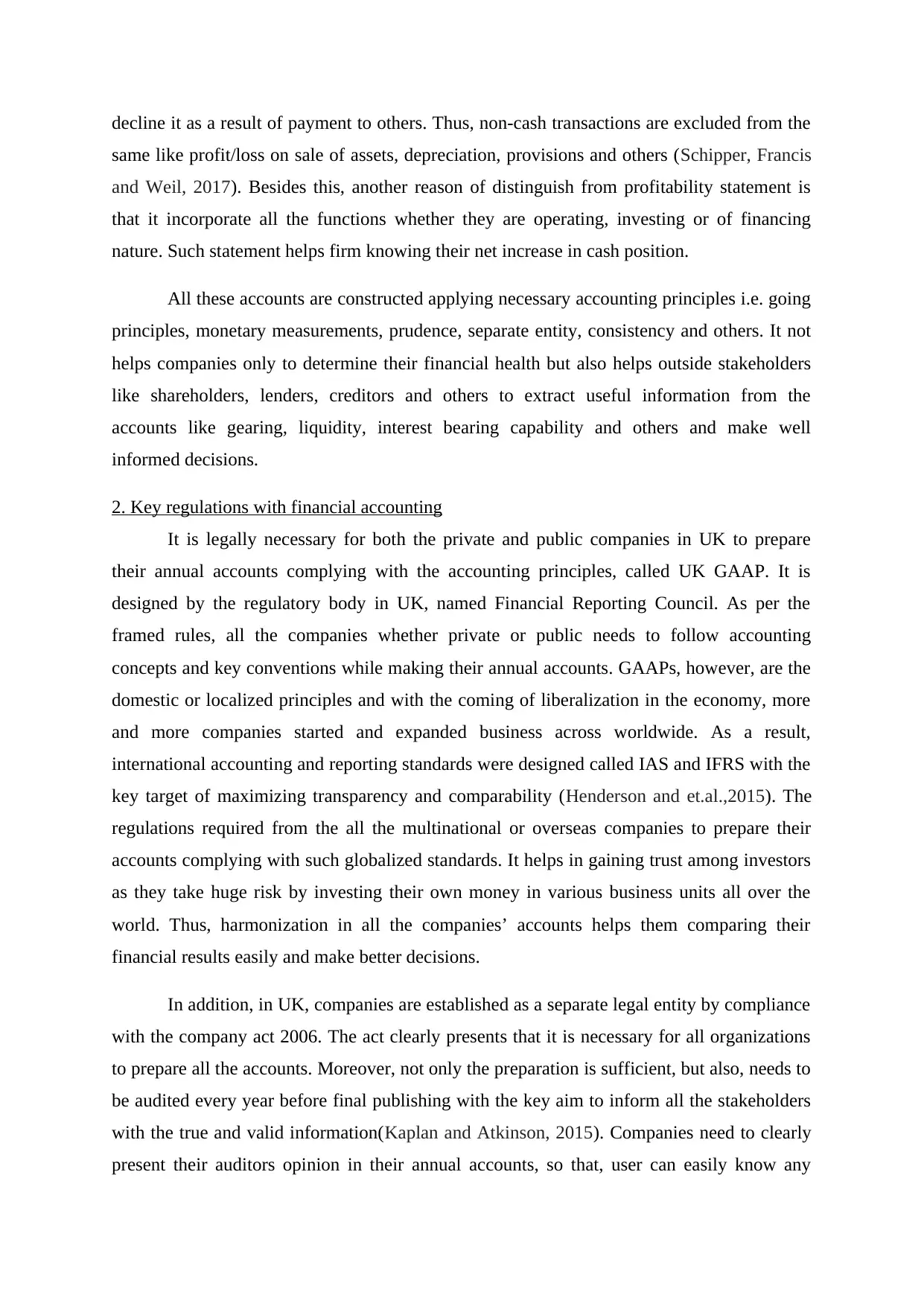
decline it as a result of payment to others. Thus, non-cash transactions are excluded from the
same like profit/loss on sale of assets, depreciation, provisions and others (Schipper, Francis
and Weil, 2017). Besides this, another reason of distinguish from profitability statement is
that it incorporate all the functions whether they are operating, investing or of financing
nature. Such statement helps firm knowing their net increase in cash position.
All these accounts are constructed applying necessary accounting principles i.e. going
principles, monetary measurements, prudence, separate entity, consistency and others. It not
helps companies only to determine their financial health but also helps outside stakeholders
like shareholders, lenders, creditors and others to extract useful information from the
accounts like gearing, liquidity, interest bearing capability and others and make well
informed decisions.
2. Key regulations with financial accounting
It is legally necessary for both the private and public companies in UK to prepare
their annual accounts complying with the accounting principles, called UK GAAP. It is
designed by the regulatory body in UK, named Financial Reporting Council. As per the
framed rules, all the companies whether private or public needs to follow accounting
concepts and key conventions while making their annual accounts. GAAPs, however, are the
domestic or localized principles and with the coming of liberalization in the economy, more
and more companies started and expanded business across worldwide. As a result,
international accounting and reporting standards were designed called IAS and IFRS with the
key target of maximizing transparency and comparability (Henderson and et.al.,2015). The
regulations required from the all the multinational or overseas companies to prepare their
accounts complying with such globalized standards. It helps in gaining trust among investors
as they take huge risk by investing their own money in various business units all over the
world. Thus, harmonization in all the companies’ accounts helps them comparing their
financial results easily and make better decisions.
In addition, in UK, companies are established as a separate legal entity by compliance
with the company act 2006. The act clearly presents that it is necessary for all organizations
to prepare all the accounts. Moreover, not only the preparation is sufficient, but also, needs to
be audited every year before final publishing with the key aim to inform all the stakeholders
with the true and valid information(Kaplan and Atkinson, 2015). Companies need to clearly
present their auditors opinion in their annual accounts, so that, user can easily know any
same like profit/loss on sale of assets, depreciation, provisions and others (Schipper, Francis
and Weil, 2017). Besides this, another reason of distinguish from profitability statement is
that it incorporate all the functions whether they are operating, investing or of financing
nature. Such statement helps firm knowing their net increase in cash position.
All these accounts are constructed applying necessary accounting principles i.e. going
principles, monetary measurements, prudence, separate entity, consistency and others. It not
helps companies only to determine their financial health but also helps outside stakeholders
like shareholders, lenders, creditors and others to extract useful information from the
accounts like gearing, liquidity, interest bearing capability and others and make well
informed decisions.
2. Key regulations with financial accounting
It is legally necessary for both the private and public companies in UK to prepare
their annual accounts complying with the accounting principles, called UK GAAP. It is
designed by the regulatory body in UK, named Financial Reporting Council. As per the
framed rules, all the companies whether private or public needs to follow accounting
concepts and key conventions while making their annual accounts. GAAPs, however, are the
domestic or localized principles and with the coming of liberalization in the economy, more
and more companies started and expanded business across worldwide. As a result,
international accounting and reporting standards were designed called IAS and IFRS with the
key target of maximizing transparency and comparability (Henderson and et.al.,2015). The
regulations required from the all the multinational or overseas companies to prepare their
accounts complying with such globalized standards. It helps in gaining trust among investors
as they take huge risk by investing their own money in various business units all over the
world. Thus, harmonization in all the companies’ accounts helps them comparing their
financial results easily and make better decisions.
In addition, in UK, companies are established as a separate legal entity by compliance
with the company act 2006. The act clearly presents that it is necessary for all organizations
to prepare all the accounts. Moreover, not only the preparation is sufficient, but also, needs to
be audited every year before final publishing with the key aim to inform all the stakeholders
with the true and valid information(Kaplan and Atkinson, 2015). Companies need to clearly
present their auditors opinion in their annual accounts, so that, user can easily know any
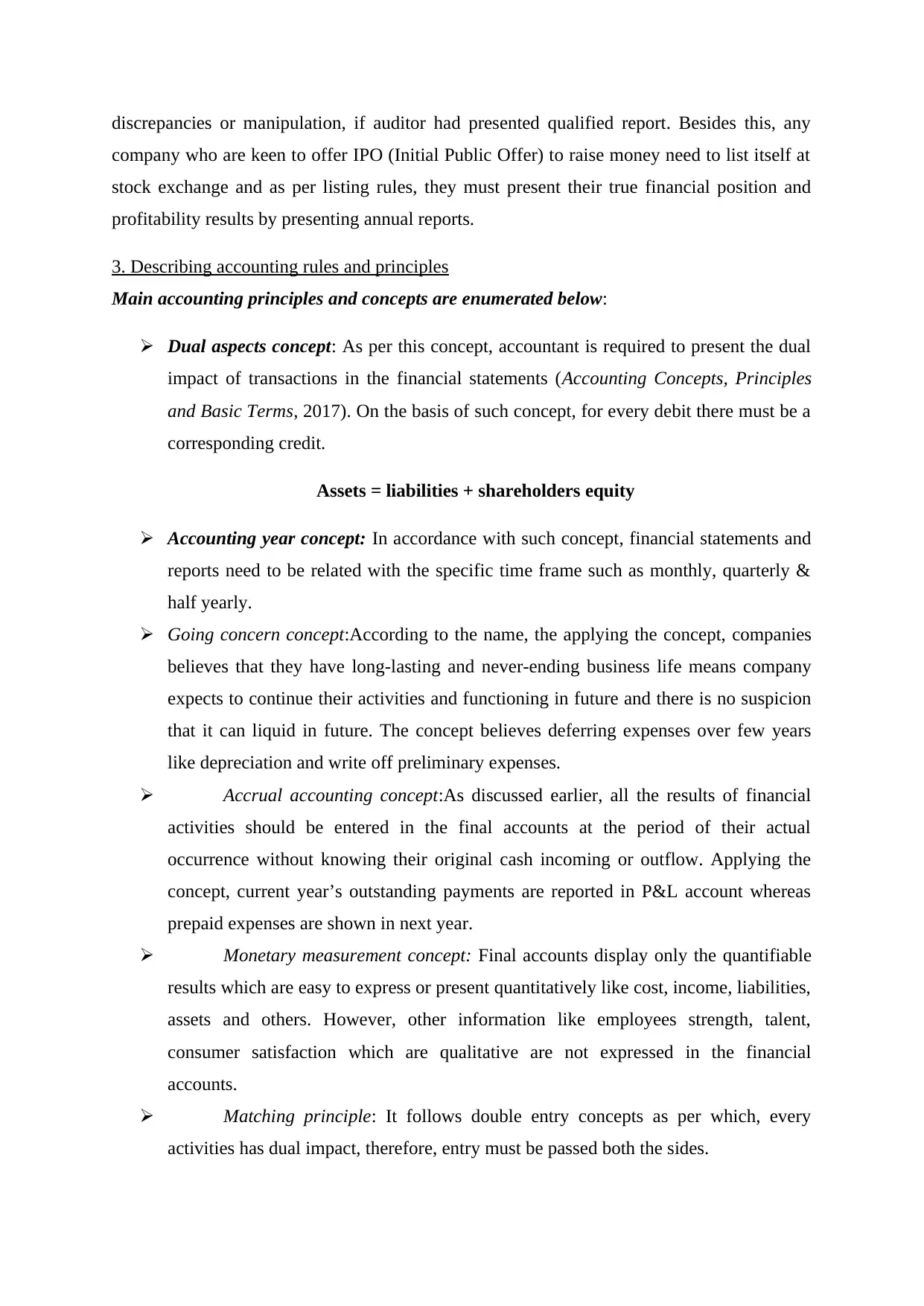
discrepancies or manipulation, if auditor had presented qualified report. Besides this, any
company who are keen to offer IPO (Initial Public Offer) to raise money need to list itself at
stock exchange and as per listing rules, they must present their true financial position and
profitability results by presenting annual reports.
3. Describing accounting rules and principles
Main accounting principles and concepts are enumerated below:
Dual aspects concept: As per this concept, accountant is required to present the dual
impact of transactions in the financial statements (Accounting Concepts, Principles
and Basic Terms, 2017). On the basis of such concept, for every debit there must be a
corresponding credit.
Assets = liabilities + shareholders equity
Accounting year concept: In accordance with such concept, financial statements and
reports need to be related with the specific time frame such as monthly, quarterly &
half yearly.
Going concern concept:According to the name, the applying the concept, companies
believes that they have long-lasting and never-ending business life means company
expects to continue their activities and functioning in future and there is no suspicion
that it can liquid in future. The concept believes deferring expenses over few years
like depreciation and write off preliminary expenses.
Accrual accounting concept:As discussed earlier, all the results of financial
activities should be entered in the final accounts at the period of their actual
occurrence without knowing their original cash incoming or outflow. Applying the
concept, current year’s outstanding payments are reported in P&L account whereas
prepaid expenses are shown in next year.
Monetary measurement concept: Final accounts display only the quantifiable
results which are easy to express or present quantitatively like cost, income, liabilities,
assets and others. However, other information like employees strength, talent,
consumer satisfaction which are qualitative are not expressed in the financial
accounts.
Matching principle: It follows double entry concepts as per which, every
activities has dual impact, therefore, entry must be passed both the sides.
company who are keen to offer IPO (Initial Public Offer) to raise money need to list itself at
stock exchange and as per listing rules, they must present their true financial position and
profitability results by presenting annual reports.
3. Describing accounting rules and principles
Main accounting principles and concepts are enumerated below:
Dual aspects concept: As per this concept, accountant is required to present the dual
impact of transactions in the financial statements (Accounting Concepts, Principles
and Basic Terms, 2017). On the basis of such concept, for every debit there must be a
corresponding credit.
Assets = liabilities + shareholders equity
Accounting year concept: In accordance with such concept, financial statements and
reports need to be related with the specific time frame such as monthly, quarterly &
half yearly.
Going concern concept:According to the name, the applying the concept, companies
believes that they have long-lasting and never-ending business life means company
expects to continue their activities and functioning in future and there is no suspicion
that it can liquid in future. The concept believes deferring expenses over few years
like depreciation and write off preliminary expenses.
Accrual accounting concept:As discussed earlier, all the results of financial
activities should be entered in the final accounts at the period of their actual
occurrence without knowing their original cash incoming or outflow. Applying the
concept, current year’s outstanding payments are reported in P&L account whereas
prepaid expenses are shown in next year.
Monetary measurement concept: Final accounts display only the quantifiable
results which are easy to express or present quantitatively like cost, income, liabilities,
assets and others. However, other information like employees strength, talent,
consumer satisfaction which are qualitative are not expressed in the financial
accounts.
Matching principle: It follows double entry concepts as per which, every
activities has dual impact, therefore, entry must be passed both the sides.
⊘ This is a preview!⊘
Do you want full access?
Subscribe today to unlock all pages.

Trusted by 1+ million students worldwide
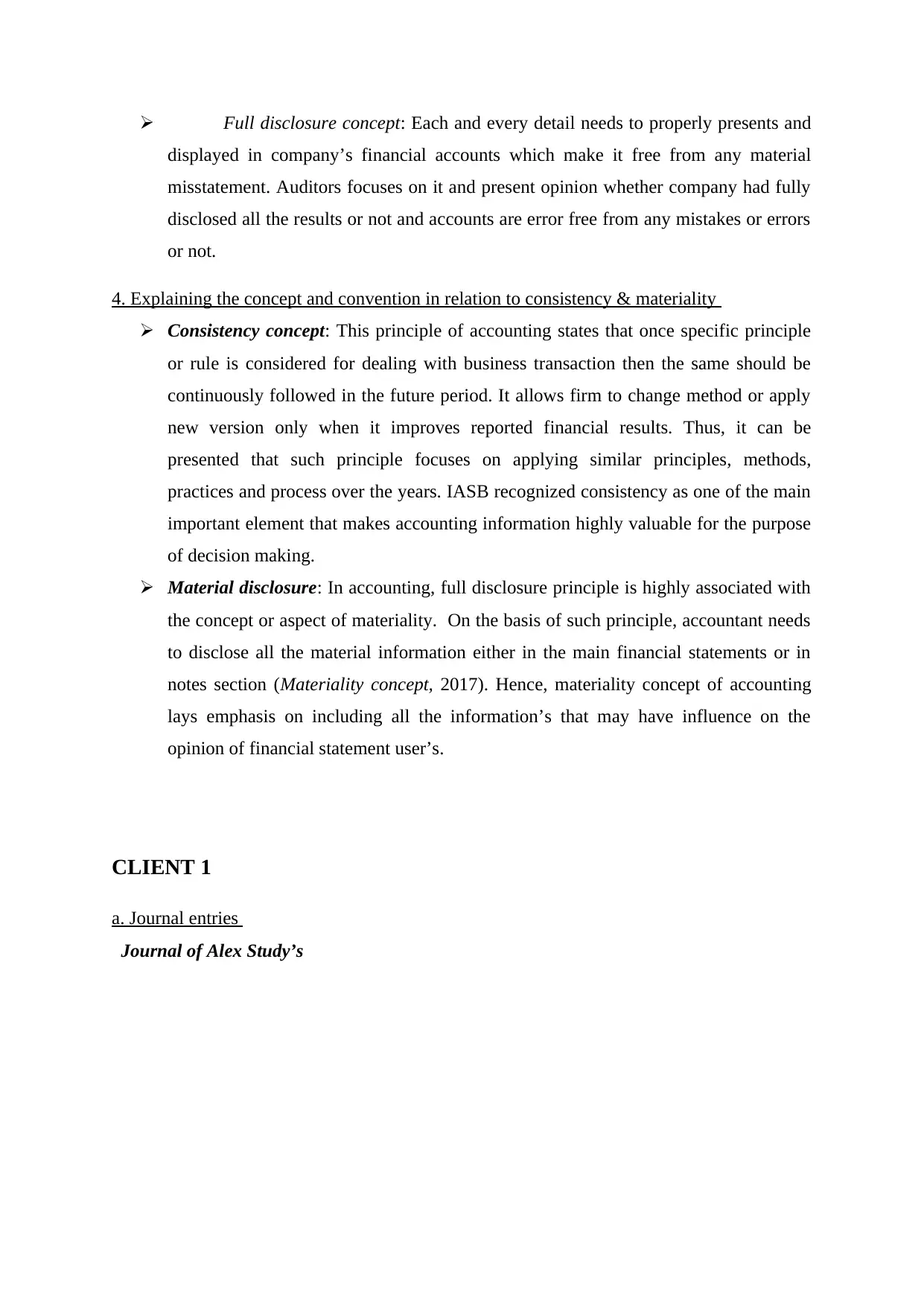
Full disclosure concept: Each and every detail needs to properly presents and
displayed in company’s financial accounts which make it free from any material
misstatement. Auditors focuses on it and present opinion whether company had fully
disclosed all the results or not and accounts are error free from any mistakes or errors
or not.
4. Explaining the concept and convention in relation to consistency & materiality
Consistency concept: This principle of accounting states that once specific principle
or rule is considered for dealing with business transaction then the same should be
continuously followed in the future period. It allows firm to change method or apply
new version only when it improves reported financial results. Thus, it can be
presented that such principle focuses on applying similar principles, methods,
practices and process over the years. IASB recognized consistency as one of the main
important element that makes accounting information highly valuable for the purpose
of decision making.
Material disclosure: In accounting, full disclosure principle is highly associated with
the concept or aspect of materiality. On the basis of such principle, accountant needs
to disclose all the material information either in the main financial statements or in
notes section (Materiality concept, 2017). Hence, materiality concept of accounting
lays emphasis on including all the information’s that may have influence on the
opinion of financial statement user’s.
CLIENT 1
a. Journal entries
Journal of Alex Study’s
displayed in company’s financial accounts which make it free from any material
misstatement. Auditors focuses on it and present opinion whether company had fully
disclosed all the results or not and accounts are error free from any mistakes or errors
or not.
4. Explaining the concept and convention in relation to consistency & materiality
Consistency concept: This principle of accounting states that once specific principle
or rule is considered for dealing with business transaction then the same should be
continuously followed in the future period. It allows firm to change method or apply
new version only when it improves reported financial results. Thus, it can be
presented that such principle focuses on applying similar principles, methods,
practices and process over the years. IASB recognized consistency as one of the main
important element that makes accounting information highly valuable for the purpose
of decision making.
Material disclosure: In accounting, full disclosure principle is highly associated with
the concept or aspect of materiality. On the basis of such principle, accountant needs
to disclose all the material information either in the main financial statements or in
notes section (Materiality concept, 2017). Hence, materiality concept of accounting
lays emphasis on including all the information’s that may have influence on the
opinion of financial statement user’s.
CLIENT 1
a. Journal entries
Journal of Alex Study’s
Paraphrase This Document
Need a fresh take? Get an instant paraphrase of this document with our AI Paraphraser
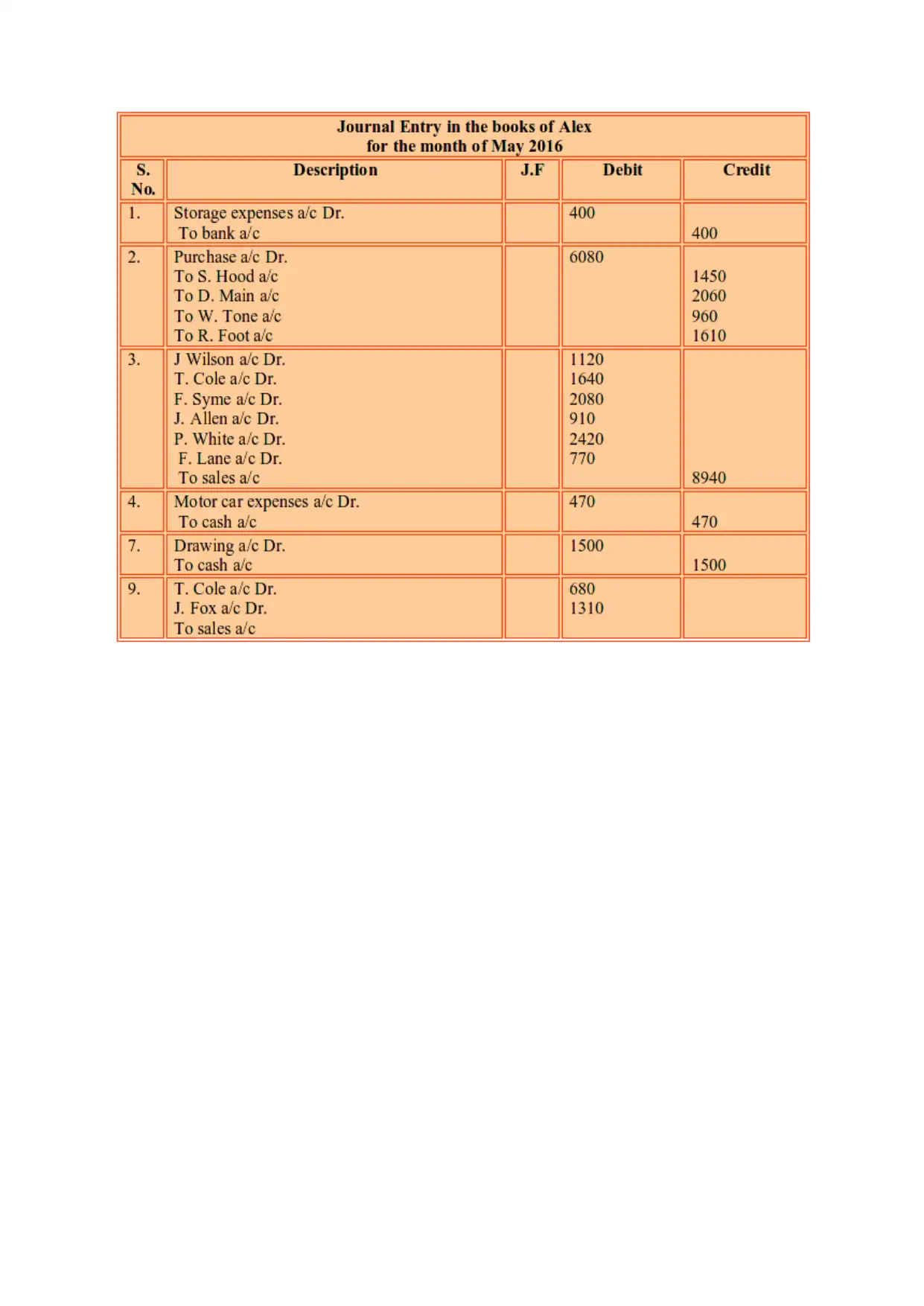
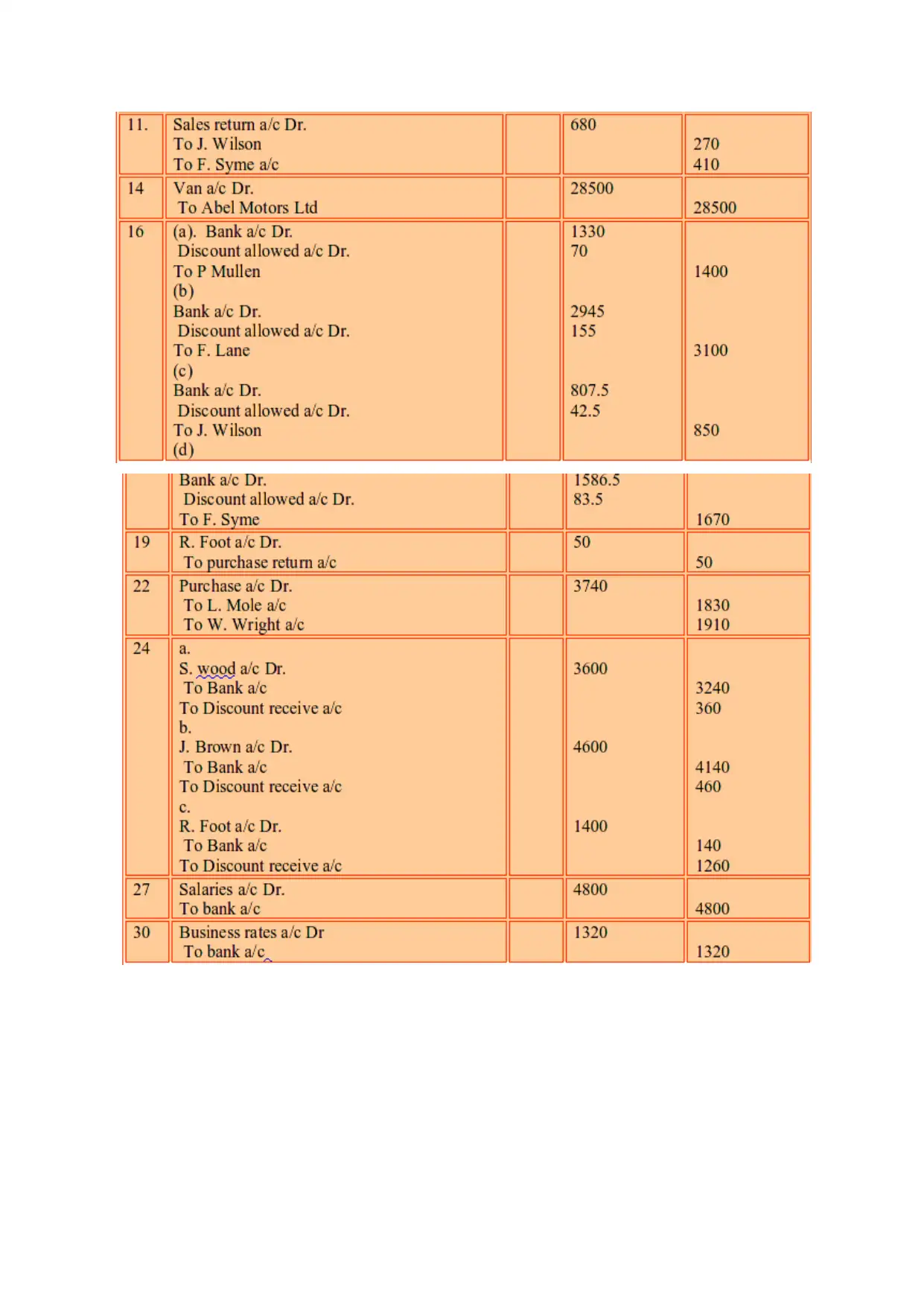
⊘ This is a preview!⊘
Do you want full access?
Subscribe today to unlock all pages.

Trusted by 1+ million students worldwide
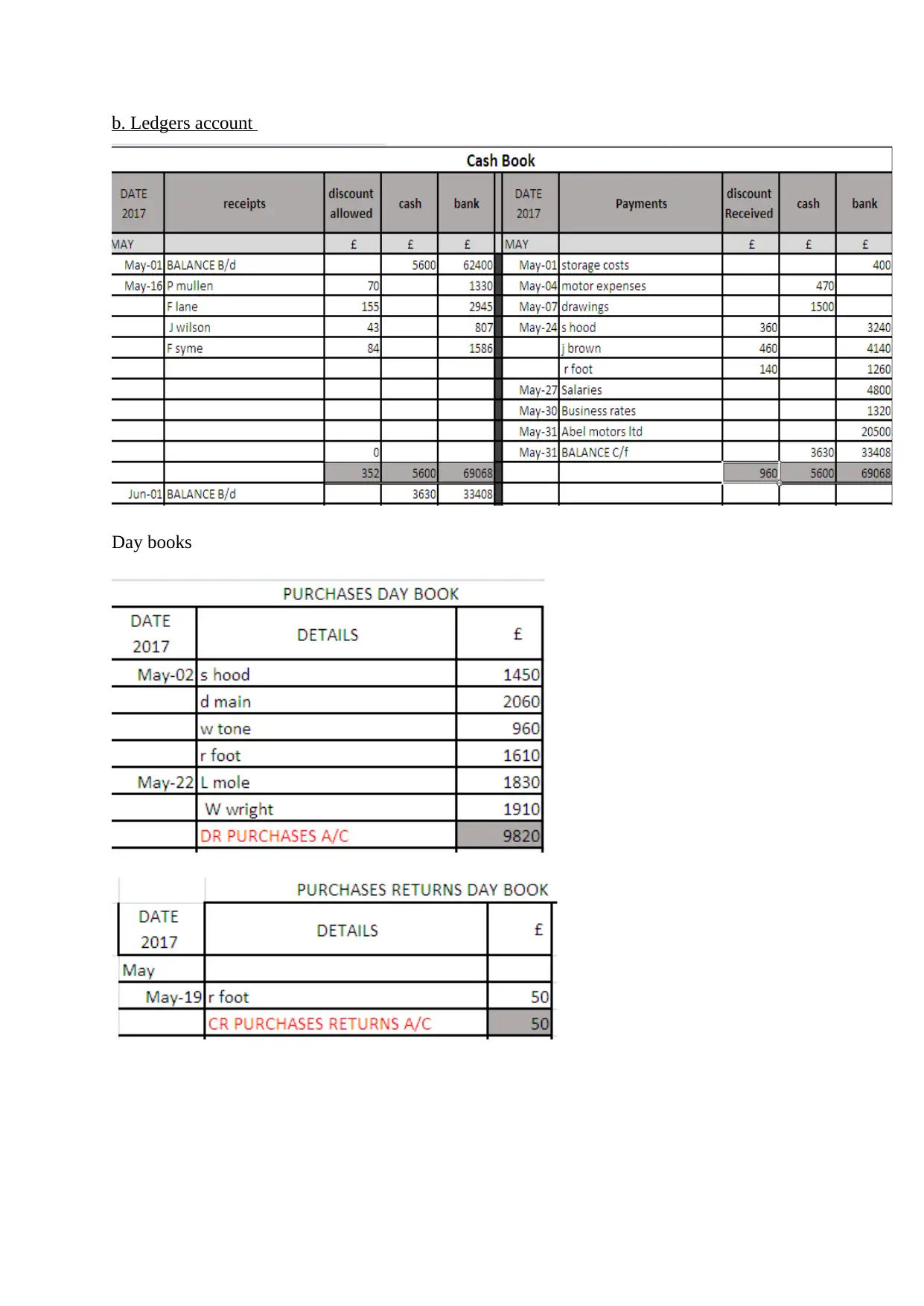
b. Ledgers account
Day books
Day books
Paraphrase This Document
Need a fresh take? Get an instant paraphrase of this document with our AI Paraphraser
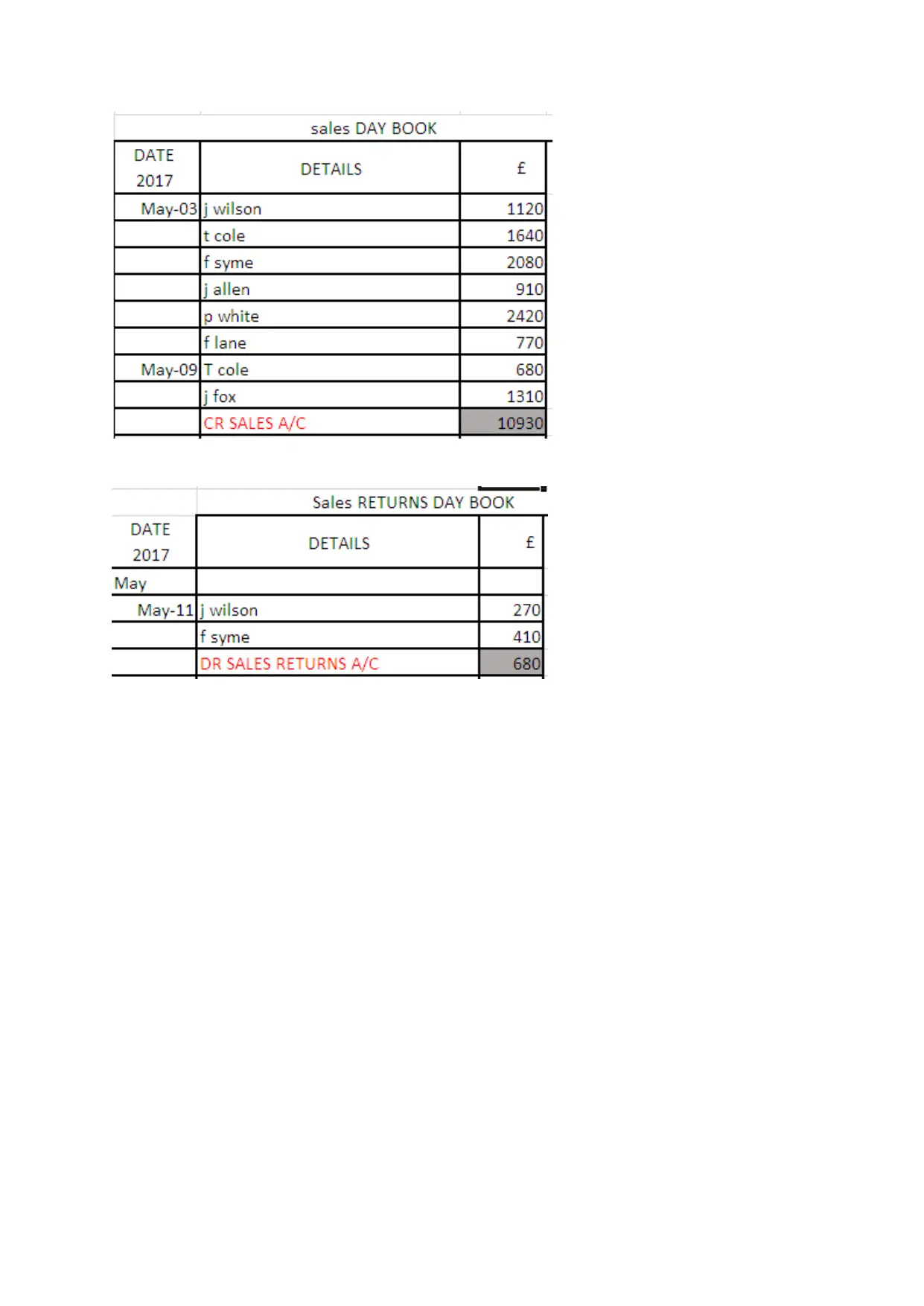
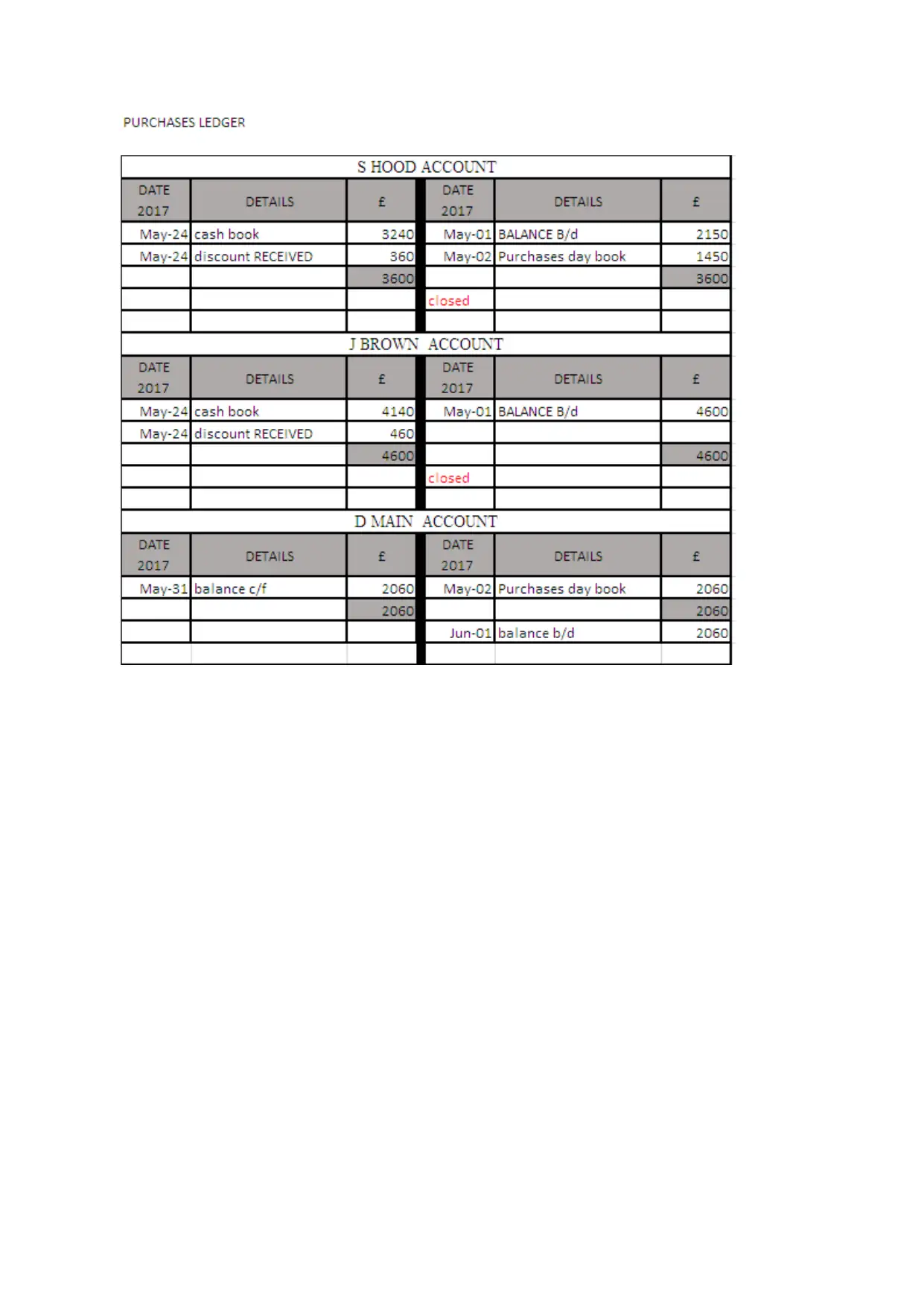
⊘ This is a preview!⊘
Do you want full access?
Subscribe today to unlock all pages.

Trusted by 1+ million students worldwide
1 out of 33
Related Documents
Your All-in-One AI-Powered Toolkit for Academic Success.
+13062052269
info@desklib.com
Available 24*7 on WhatsApp / Email
![[object Object]](/_next/static/media/star-bottom.7253800d.svg)
Unlock your academic potential
Copyright © 2020–2025 A2Z Services. All Rights Reserved. Developed and managed by ZUCOL.





